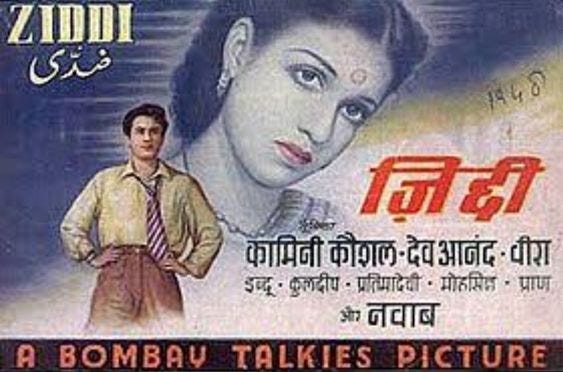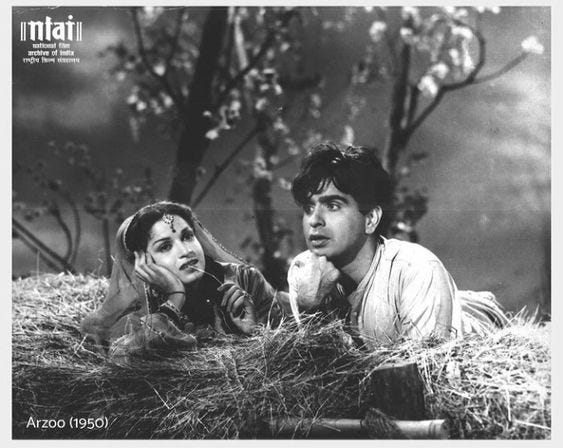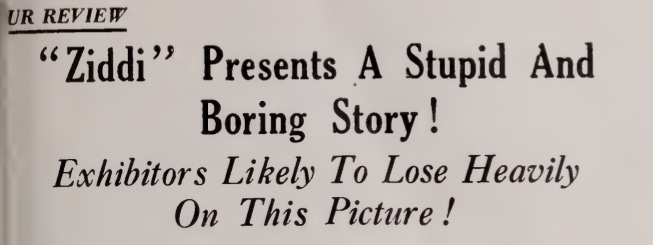Recap-
Dev Anand is reeling under the first impact of love and moderate failure of Vidya. A hit would consolidate his standing in the Industry.
Does Ziddi bring him luck?
Ab Aage-
The behind the scenes story of Ziddi is a story of coincidences, of serendipitous encounters sculpting destinies and shaping the history of Indian Cinema.
Dev Anand’s unexpected meeting with the writer-director couple Shahid Latif and Ismat Chugtai in the train prompted them to cast him in their film Ziddi, produced by Bombay Talkies, as opposed to Nasir Khan who was also in the running for the same role.
They asked him to come to Bombay Talkies, where he was introduced to his idol Ashok Kumar, who was running the studio in 1948.
Bombay Talkies was an influential, extremely profitable and trendsetting Film Studio, credited for modernising film storytelling in the Hindi film industry. Their film Kismet 1943, starring Ashok Kumar, and it’s portrayal of an anti-hero is still considered to be one of the biggest hits of Hindi Cinema ever.
Dev Anand, by his own admission, was quite overwhelmed on meeting Ashok Kumar, who offers him Ziddi. Upon asking how much he will charge, he says, ‘…you just make a good actor out of me. That is the price I want to charge for the film’.
He was cast opposite Kamini Kaushal, who was ‘discovered’ by Chetan Anand and had acted in his first film Neecha Nagar.
As I write this in 2024, Kamini Kaushal is 97 years old and her last performance was as recent as 2022 in Lal Singh Chaddha. I would be hard pressed to think of another artist with that kind of career longevity and for most of it she has been active and visible. For a star of her status to branch into writing for children, adapt to new media technology - television at that time- she is the role model we need.
Daughter of a respected Botanist, she studied Eng Literature at Govt College Lahore where Chetan Anand and Dev Anand had studied. Her name was Uma Kashyap when she was invited to act in Neecha Nagar. Chetan’s wife Uma Anand was also acting in it hence she was renamed Kamini Kaushal and the name stuck. At 19, she was already a mother of 2 girls. When her elder sister died in an accident, Kamini Kaushal decided to marry her brother in law, to help bring up their infant daughters. That brought her to Bombay and made it possible for her to explore acting in films.
While shooting Ziddi she was simultaneously shooting Shaheed with Dilip Kumar. Ismat Chughtai had written the story for both. Dilip and Kamini fell deeply in love with each other. Ismat Chugtai would tell Dev how Dilip and Kamini would hold hands on the set and hide it under the folded script. (The Thespian: Life and Films of Dilip Kumar - By Urmila Lamba)
Since Kamini was committed to her family by marriage, eventually she decided to part ways leading to heartbreak for both of them.
Kamini told Filmfare, “We were both shattered. We were very happy with each other. We shared a great rapport. But that’s life. I can’t dump people and say ‘Enough now, I’m going!’ I had taken on the girls. I wouldn’t be able to show my face to my sister. My husband, a fine human being, understood why it happened. Everyone falls in love.”
Meanwhile, on the sets of Vidya, which was likely being shot simultaneously, Dev-Suraiya were getting romantically involved- hiding from Suraiya’s dictatorial grandmother. Kamini would play the go between, passing on Suraiya’s letters to Dev. Ismat, on the other hand, would advise Dilip on the futility of his affair with Kamini Kaushal.
It sounds like the set was a cauldron of seething emotions.
Ismat Chugtai, the giant of Indian literary sphere, whose work and influence I can’t summarise in one paragraph; who had written her most influential/discussed/ anthologised work- short story Lihaaf- in 1942 (at the age of 27!). She was writing about gender and sexuality, intersecting with oppression and class issues. Lihaaf is a story about the affair between Begum Jaan and her masseuse. Ismat was taken to court on charges of obscenity for the story.
She went on to work in the film industry as story/dialogue writer, producer and director.
‘Ziddi’ is based on her first novella that she had written in 1941. It was about the romantic relationship between a girl employed as a maid and the employer’s Son.
The film starts with Dev Anand (Puran) visiting a dying old woman who had been a maid servant or caretaker for his Chachaji at some point. At the behest of Chachaji, the old lady’s granddaughter Kamini Kaushal (Asha) is brought to live with them, where she is employed as a maidservant.
Dev Anand is a kind, frolicking, carefree young man, indulged by the whole family. Kamini and he fall in love, but the maalik-naukar divide doesn’t allow it to be. They try to elope. Elder brother chases them and the horse carriage slips, throwing Kamini Kaushal into the river. Taking her for dead, they force Dev to marry Kuldip Kaur. But she’s not dead! She was rescued by…Kuldip Kaur, who took her home and made friends with her. Thats where she now lives, hoping that soon Puran will come and take her away. She has written him a letter and given it to Kuldip’s mother to post, but - oho, bhool gayi.
When Dev is brought to Kuldip’s house to meet her for the first time, he is so aggrieved that on seeing Kamini he thinks he is hallucinating and flees from the scene, leading Kamini to think she never meant anything to him.
Dev-Kuldip get married while Dev continues his slow decline into disequilibrium.
Night of the marriage he realizes that Kamini is alive and present. Alas, he is now in a loveless marriage. Kuldip tries- raves and rants- and then runs away with Pran. On the way, she decides she doesn’t actually want to run away, so they get into a scuffle while on the bridge and the car slips and falls into the raging river underneath. We don’t hear of them again.
The original novella ends with Puran (Dev’s character) dying in Asha’s (Kamini) arms and Asha setting herself on fire along with Puran’s corpse in his room. It is quite emotionally wrenching. I don’t see it becoming a hit film. They didn’t either, so in the film Kamini Kaushal is brought back…the family just relents. Happy reunion! Feeble, but more in tune with what people would like to see. Neecha Nagar’s failure to launch commercially is a fresh wound. No one wants a repeat.
Ismat and Latif tried to maintain a liberal tone- with Puran refusing to censure his wife’s affair with Pran, saying since he cannot make her happy, she is free to look elsewhere - yet they throw her to her death in a convenient ending to an illicit affair which must not get social sanction. With such great names behind it, my expectations were high. The film is disappointing. But it’s an important film in Dev Anand’s trajectory.
Dev Anand said that Ismat and Shahid would be spending so much time debating on the set that he had to ask Ashok Kumar to intervene.
Siddharth Bhatia in his warmly written, definitive book on Navketan ‘Cinema Modern-the Navketan Story’- quotes Dev Anand - ‘Though Shahid Latif was the director, his wife Ismat Chughtai, who was the story writer, used to be present on the sets. They would never agree on anything and would argue after every shot. Ismat had a very strong, overbearing personality. It became too much for the actors and one day I went to Ashok Kumar and threw up my hands saying I couldn’t work like that. Finally he stepped in and told them to get on with making the film instead of debating and discussing all the time’.
It’s great gossip but more than that it’s a small instance of how the studio exerted influence and control over the filmmaking process, a reminder that creativity and business are constantly trying to find compatibility in this Industry. Studios worked like offices for everyone- producers, directors, stars and all technicians. Even if you didn’t have a task to fulfill, you had to be on set. This gave everyone time to work on their craft. (sometimes too much time!)
Guru Dutt’s Cinematographer V K Murthy mentioned in an interview
‘One could do a lot of experiments in the studio. We had time, we had to go there every day, even if there was no shooting. Make-up man was there, assistants were there, props were there, the carpenter was there, lights were there, properties were there and the lab was there. We could try things out, print and see the results. This made a lot of difference to the work. We could do what we liked. All this is possible only when you have everything at your command, otherwise it is not possible.’ (india-seminar.com)
Common friend, the Progressive writer Manto had helped cast Pran and Kuldip. He had met Pran through his other best friend, the now largely forgotten Shyam. Manto says Pran was ‘a man without malice’.
In a case of reel life reflecting real life- Pran and Kuldip Kaur were rumoured to be in a relationship off screen as well, continuing from their days in Lahore. Manto says Pran was like a ‘male mistress’ to Kuldip.
She was married at 14 to a rich Sikh landlord with royal heritage but chose to move to Bombay after Partition and stayed separated from her husband. Manto in his book ‘Stars from another sky’ dedicates an entire chapter to her - ‘Kuldip Kaur- Too hot to handle’
According to one story, at the time of Partition, when KK (as Kuldip Kaur was called) and Pran moved together to Bombay, Pran had abandoned his car behind in Lahore (which KK may have gifted him). Known to be a fearless, confident and a bit of a daredevil, she went back to Lahore, while the Hindu-Muslim riots ravaged the border villages, and drove his car from Lahore straight to Bombay. But most of Manto’s piece is about Shyam’s amorous pursuit of Kuldip and her ambiguous refusal to entertain his affections.
Ziddi was Kuldip Kaur’s first Hindi film. It was an important film for Pran as well, it helped establish him as an actor in demand. Overall, the film did well for everyone.
Unfortunately, this firebrand had a short life. She died of tetanus at the age of 33, from a thorn in her foot. Shyam, too, died a tragic death at 31, of a horseriding accident while shooting. Incidentally, Shyam’s daughter - Sahira Kazmi- who grew up in Pakistan, produced the famous Pakistani drama of our childhood - Dhoop Kinare.
Back to Ziddi.
The film also launched another star- another KK - Kishore Kumar. He sang his first song for screen- ‘Marne ki duaein kyu maangu’ - for Dev Anand.
The film features the tuneful - ‘chanda re ja re ja re’, sung by Lata Mangeshkar who was yet to become a star. The song was parodied by Kishore Kumar in a later film- kaga re ja re ja re.
Prem Dhavan, the lyricist, kind of reworked his own lyrics for the 1962 film Private Secretary- ‘ja ja re chanda ja re’ - also sung by Lata Mangeshkar.
Chanda re - Kamini Kaushal in Ziddi
Khemchand Prakash, music director for the film was responsible for setting the course of Hindi film launching Kishore Kumar and Lata Mangeshkar, giving them songs that made them shine. For some reason, the film credits have Anil Biswas as the Music Composer and I couldn’t figure out why.
Dev Anand’s lackadaisical hunting in ‘Marne ki duaein kyu maangu’
Nasreen Munni Kabir in Lata’s biography narrates how Lata Mangeshkar on her way to the recording of her duet with Kishore Kumar for Ziddi mistook Kishore da for a stalker as he was heading to the exact same location as her, taking the same train, getting off at the same station, taking a tonga that followed her to the studio…
Son of a Dhrupad vocalist and Kathak dancer Govardhan Das from the Jaipur Gharana, Khemchand Prakash was trained in both arts and spent a few years at the Nepal court from where he went to Calcutta (New Theatres) and moved on eventually to Bombay.
‘Mahal’, with it’s iconic song- ‘ayega aanewala’ that catapulted Lata to centrestage was among Khemchand Prakash’s last films.
FilmIndia review(June, 1949) did not give anyone any credit for anything in the film- from Wirsching the Cinematographer to Khemchand Prakash or Shahid Lateef.
‘Wirsching should see some other Indian pictures, in which Kamini looks as pretty as a doll’
Wirsching was a German cinematographer, who spent his entire life shooting films in India- first for Bombay Talkies and later Kamal Amrohi.
‘Prem Dhavan has given some good lyrics but Khemchand has cast them in his old Ranjit tunes, thereby making even the words look old Shahid Lateef's direction is still very amateurish and half-hearted.’
‘Dev Anand, has a spineless role as the hero and he portrays it in a spineless manner. This boy’s approach to work, we guess, is getting shadowed by easy success. What a pity to see some good material going to dogs so soon!’
Regardless, this film is significant for so many reasons and for propelling the right people in the right direction. It was also a commercial success.
None of the above reviews managed to pull Dev Anand down. The film did well, he bought his first car. Dev was finally being noticed, by the audience, Producers and the spectacular Suraiya. He was thriving under her adulation. He says, ‘she had a great intellect, and influenced by her, I swam in a current that was both energizing and intellectually stimulating’.
It emboldened him, fed his creative spirit and pushed him to achieve heights he could barely conceive of.
But I must close this one with this letter from the section ‘Editor’s Mail’ in Filmindia., a query from a spectator answered by the Editor Baburao Patel.
His next film was ‘Hum Bhi Insaan Hain’, for me one of the better films.
- agle episode mein












